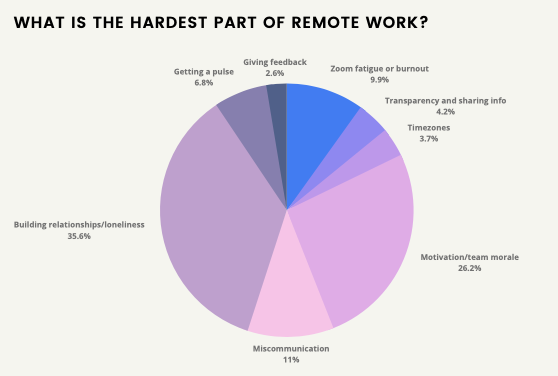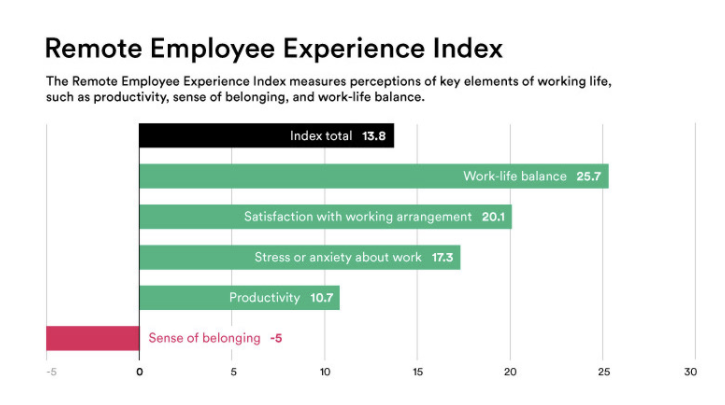Community Building: A case study
by Melissa
Why is community building in workplaces important?
The importance of relationships and relationship-building are self-evident: humans are an incredibly social and community-oriented species. Our desire for belonging, inclusion, and meaningful relationships are true everywhere—workplace included.
While you can go back-and-forth forever about whether you should see your coworkers as a “family” or a “team”, the fact remains: strong relationships between teammates lead to better outcomes in all aspects of work. We feel this fact very intuitively: we tend to like, and often feel attached to, companies where we have strong relationships. We love the feeling of a “work high” after a collaboration session with a teammates, and we take great pride in shared accomplishments.
When COVID-19 happened, most companies were forced to embrace some form of remote work. As the pandemic dragged on and remote work continued, more and more people started feeling isolated and disconnected from their work colleagues and team. This led to lots of other downstream effects, such as: burnout, job dissatisfaction, and high churn.
Unsurprisingly, focusing on building online bonds and strengthening team culture is crucial for employee happiness, team output, and retention. As it turns out, an overwhelming majority of remote workers say the hardest part of remote work is building relationships, loneliness, and team morale. (Source: Kona HR, Remote Manager Report)
 Hardest Parts of Remote Work
Hardest Parts of Remote Work
To build on this point, remote workers are most dissatisfied with their sense of belonging to their teams. (Source: Slack Future Forum, Remote Work Index)
 Remote Employee Index
Remote Employee Index
Why is building community in the workplace difficult?
OK, cool—you’re now convinced that community building in the workplace is important. Congrats! You’re already ahead of most people. 🙂 When employers think about addressing high churn or lack of employee engagement, strengthening team bonds is often over-looked. There are a few reasons why this is the case:
- Employee engagement is notoriously difficult to measure. There aren’t any standardized metrics for what an “engaged” employee looks like. Other metrics, such as onboarding success (“did an employee achieve their onboarding goals?") are much easier to track and improve. Lots of workplaces implement pulse surveys, but in most cases they happen too infrequently. Even in the cases where they do happen frequently, they tend to be less quantitative and more qualitative (e.g. “how did you feel this week?").
- There isn’t a dedicated person at the company to think about employee engagement and team bonding. As a result, this responsibility typically falls onto the manager or people operation manager’s shoulders. Their primary responsibilities and competencies are usually in other areas, such as management or recruiting, and so they unwittingly let focusing on team events and bonding fall to the wayside.
- There’s a lot of logistics and details involved. From ideating and creating fun virtual events that are actually suited for an online setting, to the nitty-gritty of planning, sending out calendar invites, reminder emails, and actually hosting the event…it’s a lot for any one manager to take care of, particularly when (see point 2 above!) they have tons of other responsbilities involved.
What does community building in the workplace look like?
Today, bonding in the workplace typically falls in one of two buckets: water coolers and virtual team events.
Water coolers are typically bottoms-up driven by the employee. Anyone can initiate a hangout, and people can choose to do so based on whoever else is free. On the other hand, virtual team events are typically initiated by the team manager. They’re planned weeks in advance and are scheduled (not spontaneous). Examples of different apps in these two buckets follow.
Spontaneous “Water Coolers”
Virtual Team Events
Learnings – how to successfully build community in the workplace
Leverage Similarities
- Strong desire to connect and build relationships with others in the community
- Shared commonality with other people in the community (same team, could even be same company)
Lean on an Organizer
- Some relationships happen in a bottoms-up way but usually a community organizer (in our case, a People Operations Manager) provides a way for those people to meet first
Understand Employee Differences
- Different events are better suited for different types of personalities
Make it incredibly easy for the manager
- By taking care of every detail, we take a huge load off of their shoulders
Discussion Questions
- What are examples of online workplace communities that you’ve really enjoyed being a part of? What made them so great? On the other hand, what are some examples of online workplace communities where you haven’t felt part of the team? Why was that?
- What’s the role of work in your life? How do you view your teammates and your relationship with them, and your company?
- What’s the best online virtual event you’ve been to? In what ways did it successfully build community? In what ways could it have been better?
- In your experience, what do most managers or company leaders get wrong when it comes to team bonding and social events?